Longboarding is a pretty trendy activity to do at the moment and therefore, there are many people that are starting to ride longboard for the very first time. Although it can be very appealing to just go out and buy a good longboard, there are good reasons to build one yourself.
- Building a longboard is actually really straight-forward. There is no way you can truly fail, especially if you follow this step-by-step guide carefully.
- There are no special tools needed, except for a vacuum pump, which you can buy for 50€.
- You will learn so much! There are many different techniques involved into building a longboard, such as woodworking, using composite materials, vacuforming and all the different ways to paint/finish your board.
- Perfect project to do with children or together with friends.
- You will be riding a beautiful, one of a kind longboard and everyone will ask you what brand it's from or where they can buy it!
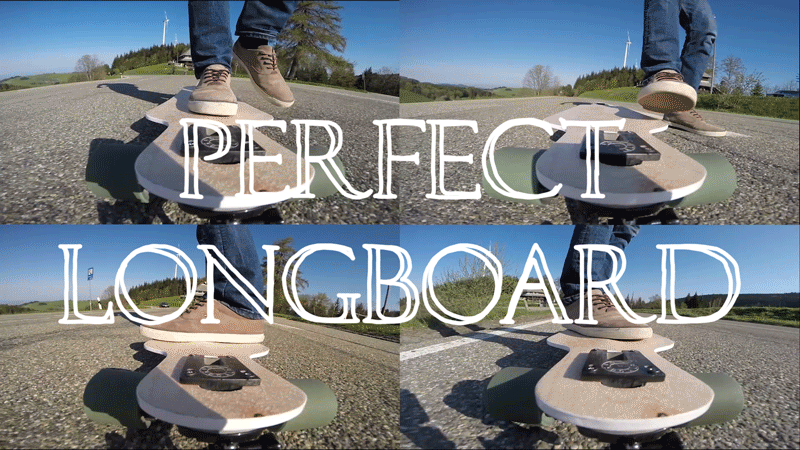
That being said, I suggest using premium materials that will unfortunately cost a premium price.
You'll end up spending about the same amount of money as you would have spent on a normal longboard but the experience you gain during the process and the fact that you actually built a high-quality longboard that you can ride on is priceless.
Materials needed:
- 6 to 7 sheets of 1.6 mm thick Canadian Maple veneers. Birch and European Maple will work as well, but both are softer and will therefore dent more quickly. If you can get your hands on Bamboo, that might also be a very good-looking pick, but it is pretty expensive so you probably want to gain your first experience with a less exotic wood. You could also use a 0.5mm veneer as top or bottom sheet to add a more premium style to your board. You can use any sort of wood you like for that, but exotic veneers often cost a lot of money.
- 1 thick sheet of Styrodur (polystyrene) to make a mold of your board.
- 500g of epoxy resin. You'll probably need about half of it, but there's nothing worse than getting low on resin and having to fear that the veneers won't stick. I found that epoxy with a processing time of 45 to 60 minutes is ideal.
- Thixotropic agent If you plan on laminating the board with fiberglass or carbon fiber. You will need a resin with a lower viscosity than the one used for gluing. If you want to make life easy, you can just buy Epoxy that is used for laminating and add a thixotropic agent (e.g. thixotropy powder) to increase the viscosity again.
- 440g/m² Unidirectional glass fabric or 300g/m² Unidirektional carbonfabric and 320g/m² Bidiagonal-Glass-Fabric or 200g/m² Bidiagonal carbon fabric. You could also buy triaxial fabrics so you don't have to buy different kinds of fabrics, but if you buy them individually, you can play around more and add different kinds of layers later on if you feel like you need more. Just buy 1 or 2m² each. Especially glass fiber is extremely cheap (4-5€ per m²) and you can always use the excess for other projects.
- Vacuum bagging film tube. You can also buy a film for vacuum bagging, but if you're using a tube, you only have to seal two ends instead of the long end as well. So I highly recommend using a tube.
- Vacuum sealant tape to close off the ends of the vacuum tube.
- Absorber/breather fabric. You can also use 3 layers of old cotton or polyester clothing, since this layer is just to let the vacuum reach every part of the board and to absorb excess epoxy.
- Peel ply. The peel ply is placed directly on to the glass fabric. Due to it's chemistry, it won't bond with epoxy but it will transfer excess epoxy to the absorber. This is not necessary but it ensures that you don't have any pockets of excess epoxy and that your board doesn't have unnecessary weight to it.
- Perforated release film. The Release Film is placed directly on the peel ply in contact with the laminate. It separates the laminate from the breather fabric, which has no release characteristics.
- Vacuum pump. I am using this one and it works perfectly fine, but make sure to add vacuum pump oil since they tend to be sold with barely any oil.
- UV resistant polyurethane varnish. A polyurethane varnish is the best varnish you can get. You can also get in spray cans if you like to spray it on. I have also tried using boat varnish but that ended up chipping off because it will get too brittle. It might be good for boats, but longboards are just too flexible for that. Montana varnish also worked out very well, especially in combination with their Montana Gold spray cans.
- Griptape or blasting sand if you want to apply a clear grip.
- Single-use-items such as latex gloves, cups, popsicle sticks, face mask, paint brushes, solvent for your paint, sandpaper etc.
- A jigsaw or a handsaw and a palm sander are highly suggested. You can probably borrow the tools from friends or from a local woodworking shop if you don't have them.
- Trucks, bearings and wheels.
Step 1: Deciding on which shape you want to have
This step is probably the most difficult one because there are so many different decisions to be made, but bear with me! Once you've decided on a shape, it'll be easy-going from there on. If this is the first board you're going to make, I would suggest copying a basic shape of a board you like and only making small changes to the overall shape if you want to. You can then draw half of the board on a large piece of paper and mirror it (by folding) along the long side of the board to make it perfectly symmetrical. I prefer to draw the shape in a vector program like Inkscape or Adobe Illustrator and using PosteRazor to create a poster of the shape in sheets of A4 paper.
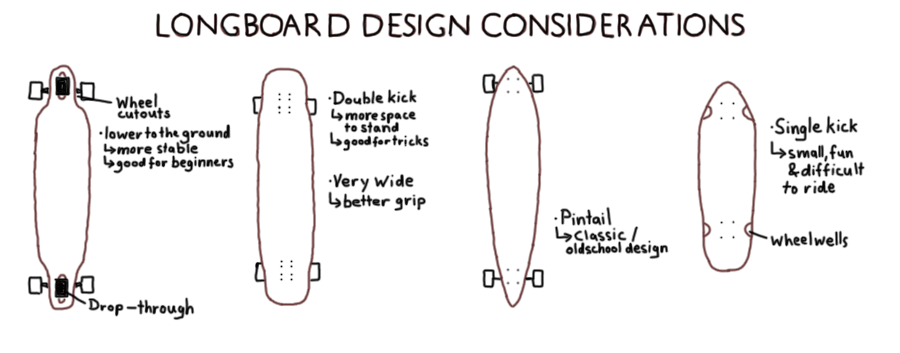
For the thickness of the board, it is probably also best to take the thickness of a board that you really like and copying it. After you make your first experiences you can get more creative if you decide on making a second board. The thickness of the board determines how flexible your board is going to be, but of course there are other variables for that. One thing to keep in mind is that if you follow this guide and use the materials listed above, your board will not break, even if you don't want to use fiberglass or carbon fiber. It might be so flexible that you bottom out on the ground but that is the worst case that can happen. In that case you can just add another sheet of veneer or fiberglass if you want to. So with that in mind, let's go over the different variables that determine the flex of your board:

- Thickness of the wood core: This is obvious. The thicker the wood core, the less flex your board will have.
- Fiberglass composition: This is not a must, but if you plan on using fiberglass (or carbon fiber), you will have to consider the fiberglass composition. Fiberglass works very well with tensional stress and very poorly with compressive stress. Therefore, the direction of the fiberglass strands have to be mainly parallel to the length of the board. To prevent torsion or twisting of the board, you can also add another fiberglass layer perpendicular to the board or add a layer of bidirectional fiberglass.
- Fiberglass thickness: As seen in the materials list, I mainly use fiberglass layers of 300 to 500g/m². Those layers are already pretty thick themselves, so one or two layers is probably enough. Thinner layers will work just as well, but it will also be much more work. I strongly suggest putting the fiberglass in between the veneer layers because fiberglass is a huge mess to work with and to get a nice finish (having to sand fiberglass is the worst!), but if you really want to put it on the outside, using thinner fiberglass layers will give a much cleaner finish.
- Fiberglass placement: Since fiberglass (and carbon fiber as well) is only strong against tensional force, you want to place it just there where the tensional force is the greatest. When standing on the board, the top will get compressed and the bottom will get stretched. Ergo, the best place to put the fiberglass is on the bottom. But as I said, finishing fiberglass is a huge pain, so consider putting another layer of veneer below the fiberglass layers so you don't have to deal with it. This probably sounds a bit confusing so please take a look at my GIF above.
- Length of the board: Of course the length of your board also determines the flex. To be precise, the wheelbase of the trucks is what is important. The flex increases to the power of 3 with the length of the wheelbase, so don't go too crazy if you don't know what you're doing!
But don't be daunted by all the different variables and materials!
Just try copying a board or a shape that you really like. You'll also find that composites like fiberglass and carbon fiber are rarely used in longboards. It is perfectly fine not to use composites if you don't want to. The trade-off would be a slightly heavier board and a not-so-snappy flex.
Step 2: Making a negative mold
Since you probably don't want to create an entirely flat board, you'll need to make a press. Making a vacuum press is definitively the fastest and easiest way to build a longboard since the negative mold is really easy to make and the pump & vacuum bag only cost around 50€.
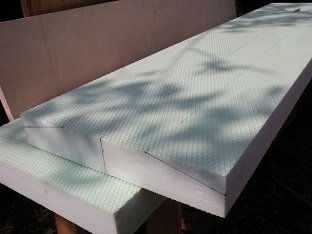 | 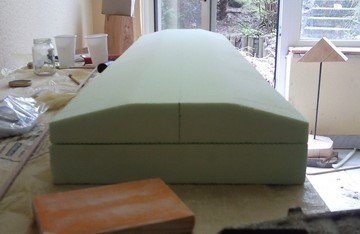 |
|---|
Just buy one or two sheets of Styrodur (polystyrene, insulation foam) from the hardware store. Then shape it with the use of rough rasps and handsaws. This process only takes about 20-30 minutes, but you might have to bend your mind a bit because everything you shape will be negative to what the board is going to look like. There is no need to over-exaggerate the negative mold in order to counteract for the for the wood that might want to bend back. If you were using regular wood glue, that might be the case, but since we are using epoxy, the board will have the exact intended shape.
To prepare for the next step, you want to cut off a piece of the vacuum bag and tape it on to the Styrodur mold. The excess epoxy that gets squeezed out while pressing, bonds very well to Styrodur and will destroy your mold. The polyaramide vacuum bag doesn't bond to the epoxy from the materials list, so your mold will stay nice.
Step 3: Pressing the board
Take your veneers and fiberglass layers if you opt on using fiberglass and stack them in the right order. You probably want to put the most beautiful veneers on the top and bottom of your board and the less beautiful sandwiched in between. If you don't want to use fiberglass or carbon fiber, 7-9 Veneers should be used for a board with quite a bit of flex and a ~70kg rider on top. You can use about 2 veneers less if you are using fiberglass or carbon fiber with the thicknesses as stated in the materials list. Just use one sheet of both unidirectional and bidiagonal sheets if you don't want to get too experimental.
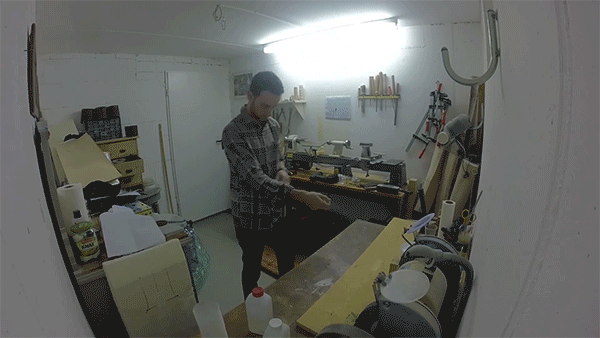
If you are using veneers only, it's just a matter of spreading the epoxy on both sides of the veneers, stacking them back together and putting them, together with the mold, in to the vacuum bag. Don't forget to use one layer of peelply and breather fabric on top of the board. The breather fabric is used for the vacuum to reach every point of the board and the peelply is used so that the fabric doesn't stick too hard to the board after pressing.
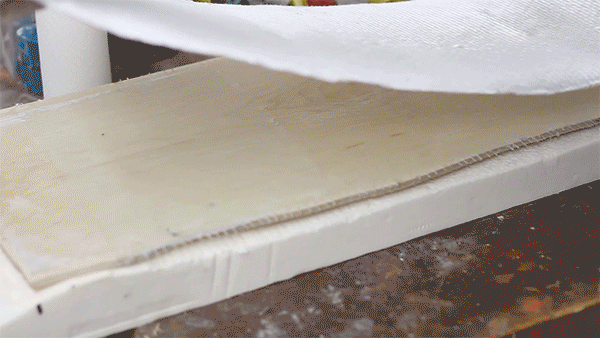
If you're using composites, you will have to press the board twice. The first press will be the top veneers and the composite layers. For the second press, you cover the composite layers up with another veneer. The process is the same as if you're using veneers only; you'll just have to do it twice.
To make the vacuum, attach a sturdy tube to the intake of the pump and put the other end in the vacuum bag. The end of the tube has to be in contact with the breather cloth in order to work well. Once everything is in place, seal the ends of the bag with the sealant tape and turn on the pump. You can often hear some hissing if there are any large leaks in the bag. If there are any, try to squeeze it better on to the tape. If that doesn't work, just use more tape. You probably won't be able to make a perfect seal but you'll know if the pressure of the pump, in spite of the minor leaks, is good enough to press the board. If that's the case, leave the pump running for at least 10 hours.
If you're not sure if your board is strong enough, you could at this point prop the board up on the two points where the trucks are going to be and stand on it. If you feel like it's not strong enough, you can add more layers by using the vacuum press again.
Step 4: Jigsaw time! ...and sanding
This is pretty straightforward. Make sure to go slow, and maybe even try it out on a scrap piece of wood first. Wearing eye protection might also be a good thing and if you used composites, you should wear a mask and latex gloves since the glass and carbon particles are very bad for your lungs and itch a lot if you get them on your skin.
Now would be a good time to make wheelwells if you want some. Place the trucks where you want them to be and imagine where they would touch the board if you would make a full turn. That's where you want your wheelwells to be. Usually you use a grinding wheel to make the wheelwells but since not everyone has a grinding wheel, you can also use a chisel or any other sharp knife to cut them. I really like the look of the cut wood, but if you don't like that, you can sand it down afterwards to make it look neat.
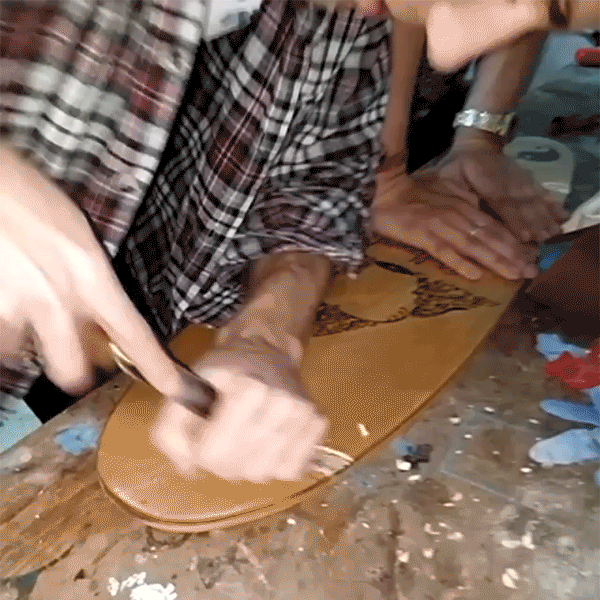
Sanding could be a pain if you didn't cut the board well. Start out with something rough like grid 80 to get rid of most of the unclean cuts, then work your way up until 500 grid or even 1000 grid.
Tip: If you wet the board every once in a while and let it dry, loose splinters will stand up and you'll be able to sand those off as well.
If you did a good job, especially with sanding, your board will now look and feel like straight out of a professional production line!
Step 5: Get creative
You can do whatever you like to your board. The only thing I would watch out for is oil-based paint. Oil-based paint is not only a huge pain to clean off since you need strong solvents for that, but it also takes very long until it's dried and the solvents of the polyurethane lacquer from the materials list above will destroy every paint job that you worked so hard on.
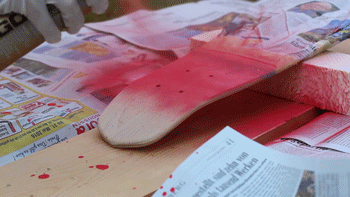 | 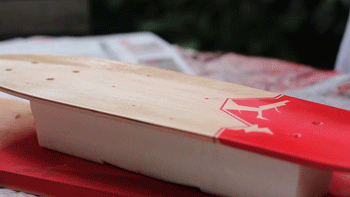 |
|---|
Here are some handy tips to make your paint job look beautiful:
- If you are using tape to cover up different areas on your board or to make straight lines, apply a thin coat of the polyurethane lacquer or the Montana spray varnish on the edges of the tape. This way the line will be perfect, since the wood won't soak up the paint and pull it beyond the tape.
- Sand after every layer of paint, but be careful of scratches. You will see every single scratch through the next layer.
- Let the paint dry. I know, at this point it can be very tempting to rush because you really want to ride your new longboard, but if you don't wait until the paint is totally dry, even in between layers, the paint can get ugly wrinkles.
- You can also print out stickers or go to a print shop to print large, high quality prints. Just stick it on and seal it with lacquer.
- Screen printing with silkscreens is also very commonly used in the skateboard industry. Why not give that a try? There are many great tutorials on the internet and the results are often very nice.
- You can also get creative with markers, engraving tools and woodburning if you feel like painting is nothing for you. Heck, you could even leave it as-is; the maple veneers are already very beautiful by themselves.
Step 6: Griptape
There are two possibilities for the griptape. You can ether buy black griptape or make a layer of sugary clear grip yourself.
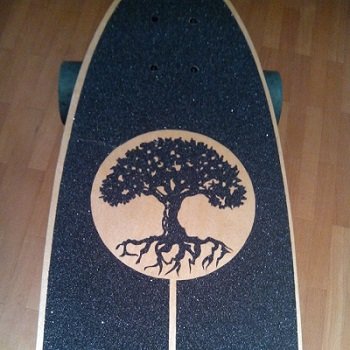
You can get the black griptape in every skate shop. You could get even more creative by cutting patterns into the tape before sticking it to the board. To do this, cut through the back side of the griptape with a box-cutter. You will need a lot of blades because the griptape is made of quarzite which is almost as hard as diamond, but the end result will be worth it.
What I like to do most of the time is to put a thin coat of epoxy on top of the varnished board and sprinkle white sand that's used for sandblasting on the epoxy. The white sand will get somewhat clear when it touches the epoxy. To make the sand even clearer, you could put another layer of lacquer on top of the clear grip. This makes the sand almost 100% clear.
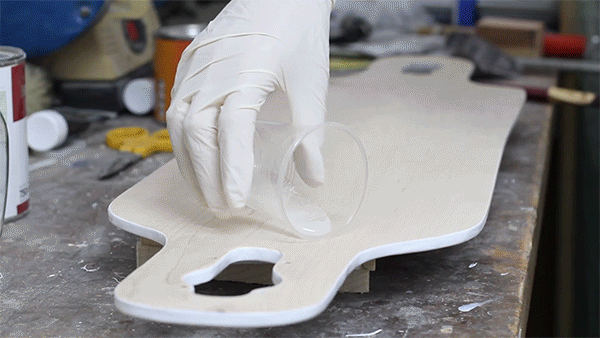
Although you can take off the normal, black griptape, there is no way you will ever get the clear grip off of your board so make sure to clean up any rough edges before the epoxy dries.
Step 7: Have some Happy Days!
 |  |  |
